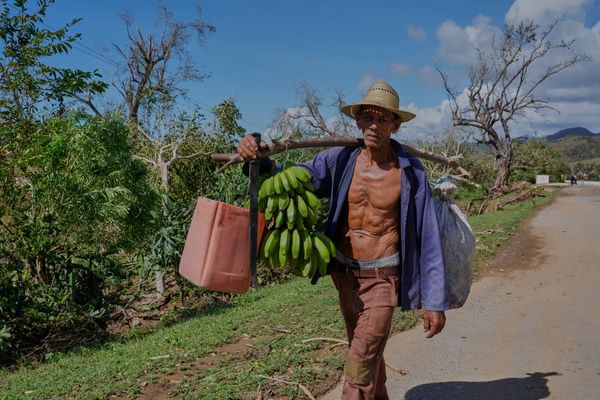
In the fall of 2022, a six-year-old boy was rushed to the emergency room at Mease Countryside hospital in Safety Harbor, Florida, a small city on western shore of Tampa Bay. “He was very lethargic, and very drowsy,” recalls Dr Francois Richer Lafleche, the admitting physician. The child had gobbled down a whole bar of chocolate that he’d stolen from his parents, unaware it was laced with psilocybin – the active ingredient in magic mushrooms.
“His eyes weren’t going from left to right, as you see on common overdoses of hallucinogenics,” Dr Lafleche says. “He was more just overly sleepy. He was fine. There were no complications. But I was just flabbergasted. A chocolate bar? I think it was called something like a Choca-dot bar?”
The brand is actually Polkadot Bar. And they’ve become increasingly common in the psychedelic grey market. As more states open up laws around cannabis, Polkadot Bars and a range of other magic mushroom containing-candies – including One-Up Bars, Holy Grail Bars, Magic Bars and Mushie Gummies – have become common, under-the-counter offerings in cannabis boutiques, smoke shops and corner bodegas. The bars come in a range of flavours, from Ferrero Rocher, Twix and Fruity Pebbles to matcha, blueberry acai and “strawnana”.
The cartoonish Wonka Bar-like packaging may entice the average child, who, as in the case of the Florida six-year-old, may well eat an entire bar without heeding that each package “contains 4 grams of mushroom”.
“I have noticed a disturbing number of social media posts of Instagram profiles, promoting the availability of psilocybin chocolates/candies for sale,” says Dr Daniel Sudakin, a board-certified medical toxicologist working in Oregon, which recently instituted a legal framework for psilocybin therapy clinics statewide. “Similar to cannabis edibles, if psilocybin products look like candy and/or are labeled like candy, and have no protective packaging, it is inevitable that these products will get into the wrong hands.”
Earlier this year, in the heart of Pennsylvania’s Amish Country, a man was charged with child endangerment after a three-year-old in his care consumed the bulk of a psychoactive candy bar, procured from an unattended backpack. Emergency responders noted that the child, who had been vomiting, was woozy, semi-alert and nauseous. Recently, in central Tennessee, several middle-schoolers were sent to a local hospital after ingesting mushroom chocolate.
This is hardly a new phenomenon. An early modern account of accidental mushroom poisoning can be found in the reporting of the English physician Dr Edward Brande. In a 1799 letter to the London Medical and Physical Journal, he reported on his eight-year-old son unknowingly consuming a “tea saucerful” of hallucinogenic fungi, and being beset in turn by “a great degree of stupor” and “fits of immoderate laughter”. More contemporary data confirms similar effects: confusion, nausea, lethargy and hallucinations.
“When you’re looking at toxicology you’re looking at how much you’re ingesting compared to the patient’s body size,” says Dr Meghan Martin, a paediatric emergency medicine specialist at Johns Hopkins All Children’s hospital in St Petersburg, Florida. The toxicological risks of overdosing are, thankfully, vanishingly small, but there is danger of risky behaviour when children are unsupervised, and of vivid hallucinations. “Because kids have a smaller body size, the effects that we see on a child are potentially greater.” Martin notes that the effects typically do not require medical treatment beyond observation, except in the event of “significant hallucinations”, in which case the children may require sedation.
“A lot of the times the kiddos are seeing things they’re usually scared of,” she says. “It’s bugs and snakes and monsters. They have very vivid imaginations.”
Jimmy Leonard, assistant director of the Maryland poison control center in Baltimore and co-author of an exhaustive survey of psychedelic incidents across America’s poison control centers explains that children admitted for accidental ingestion can often not be easily reasoned with. “How do you say to a two-year-old, ‘Yes, you are tasting colours?’” he says. “Essentially, if they are incredibly high, they are inconsolable.”
Data provided to the Guardian by the National Poison Data System shows a modest uptick in children under the age of 12 admitted to poison centres for accidentally ingesting hallucinogenic mushrooms: from 12 cases in December 2022 up to 22 in April 2023. (The data does not distinguish between children who consumed whole, dried mushrooms and those who ingested the drugs in candy form.) Of these cases, 91.3% occurred at the patients’ residences. These are not exactly alarming, “think-of-the-children” numbers. (Some may consider 22 cases, in a nation with 50 million-plus children under age 12, “statistically irrelevant”.) None were fatal. Martin notes that psychological risks are actually decreased in children, as their exposure to these drugs is usually accidental and a one-off occurrence. “Generally a limited ingestion, once or twice, would not have significant long-term issues.”
For all their trippy, mind-expanding and (more recently) therapeutic potential, magic mushrooms are relatively safe. In fact, a 2017 Global Drug Survey showed magic mushrooms were “one of the safest drugs in the world”, with only 0.2% of adult respondents requiring medical treatment. Like other psychedelics, magic mushrooms are generally not considered addictive. But even the modest increase in incidence –and the more notable proliferation of these candies more generally – speaks to larger issues in the country’s emerging, normalised-but-unregulated, destigmatised-but-not-quite-decriminalised psychedelics market.

•••
On a random, unscientific, midday tour around lower Manhattan, in search of psychedelic chocolates stocked at local retailers, this reporter was met with a variation on a theme: “Sold out”; “Polkadot? What’s that?”; “No.” One cannabis dispensary in Midtown produced a single, Lucky Charms-flavoured candy bar, imbued with psychoactive mushrooms. It was the last in stock. Another clerk was kind enough to explain that there had been a supply shortage. “No more mushrooms,” they explained. “They’re really hard to get now.”
Late last year, the NYPD made four arrests related to psilocybin products being illegally sold out of smoke shops and CBD stores. Officers recovered a trove of psychedelic products: some 1,500 pills, dozens of bags of branded raw mushrooms, and psilocybin-containing gummies and candy bars, recovered in the instantly recognisable, super-colorful wrapping. When I asked a cashier at an East Village smoke shop if these recent busts had put the fear into more audacious shops – those willing to face serious prison time for trafficking a drug that, however “normalised”, is nonetheless illegal in New York state and falls under schedule I of the United States Controlled Substances Act – he shrugged.
This seeming drought has hardly shut down other avenues of supply. On a sunny afternoon in Washington Square Park, dealers post up at folding tables under the statue of the Italian unification advocate Giuseppe Garibaldi. They sell gnarled, purple-blue shrooms from mason jars, completely at ease among the the usual cavalcade of artists, leatherworkers, pot dealers, panhandlers and bleary-eyed beardos hawking tarot card readings.
A few blocks away, on St Mark’s Place, one man moves drugs the old-fashioned way: leaning on a wrought iron fence, fiddling around with a phone, flatly announcing “magic mushrooms, psychedelics …”
In a marketplace with such apparently high demand, mushroom chocolates are tantalising. For one, the flavouring masks the rather pungent taste of uncooked mushrooms, which users have compared to “nutty dirt”, “feet” and “beautiful, magical shit”. For another, when shared in public, these bars are relatively inconspicuous (“It’s just a chocolate bar, officer”). Brands like Polkadot also offer helpful dosage guidelines for neophyte trippers: one to three pieces to “stimulate the mind”; four to nine for a “therapeutic” dose; and 10 to 15 to reach “god mode” (“Walls might melt,” the package advises).
For adults taking them intentionally, the biggest issue (beyond illegality, being caught with one of these bars would, most everywhere in the US, merit the harshest criminal penalties under current drug laws) is quality. Because these products are illegal and unregulated, it can be difficult to verify their authenticity, or if they even contain psilocybin. Knock-offs of Polkadot’s trademark wrappers are sold in bulk, on Amazon and elsewhere, alongside foil wrapping, chocolate molds and other tools for the at-home confectioner.
As one YouTuber put it: “Polkas are the Dank Vapes of shrooms.” For readers who lack fluency in head shop lingo, Dank Vapes are weed vape cartridges with wrappers that are frequently doctored or counterfeited and sold online to unsuspecting customers. Branded packages are bought by sketchy dealers, who load the vape cartridges with, well, whatever. One critic called it “the biggest conspiracy in pot”.
The blooming – or sprouting? – market of grey market psychedelics relies on a similar degree of shadiness. The fungal-curious may trust certain brands, precisely because they seem legit: with commercially printed packaging outlining dosage guidelines and even nutritional information (a standard Polkadot bar boasts 800mg of “Magic Blend”). Even this metric is confusing. Elsewhere, the standard packaging boasts that each bar contains 4 grams (or 4,000mg) of mushrooms. (The disparity may be accounted for by the larger number representing the weight of ground, dried mushrooms, where the smaller “magic blend” number refers to the approximate amount of psychoactive psilocybin, specifically.)
Due to the criminalized status of these products, customers in the marketplace are naturally uneducated, and may (just as naturally) confuse the appearance of legitimacy with legitimacy itself.
Of late, reports have popped about “fake bars”. One user, a psychedelic veteran who purchased from someone they considered a trusted dealer, tells of a friend who had a seizure after eating two whole bars, in an attempt to exceed even god mode.
“We hear a loud thud and turn around and see my best friend laying on his back,” they tell me. “After 15 seconds of seizing, he stops and his eyes open wide, and he asks who I am, and where he is, and backs into the corner like a scared puppy.” His friend stabilised after a few minutes, and there were no lingering effects. After doing some research, the user was convinced the bar was fake and was filled with designer drugs, or so-called “research chemicals”: synthesised psychoactive analogues commonly sold over the internet.
The average, psychedelically curious individual would probably have their anxiety mitigated by knowing the exact ingredients of their bar. For their part, Polkadot (or someone anonymously speaking for them via their Telegram channel) assures me the bars contain “natural shrooms” and not compounds like 4-AcO-DMT, a research chemical that provides a psilocybin-like effect and is sometimes called “synthetic shrooms”.
“Genuine” Polkadot bars include QR codes on the wrapper, which authenticate the product by linking to their official Telegram presence. But this level of authentication may well elude the average consumer who might just want to, well, get a little high and watch the walls melt.
For adults who do this accidentally, the results can vary wildly. On social media, silly videos circulate of people filmed after unwittingly consuming mushroom chocolate. Wide smiles, bugged eyes, and those “fits of immoderate laughter” described by Dr Edward Brande back in 1799 abound. “I have never been so fascinated by trees,” on TikToker enthuses.
Other experiences are more intense. One Redditor describes watching their husband after he accidentally ate some mushroom chocolate. “He started with the giggles,” the Redditor says, “but sounds like past family issues are starting to come up and he’s having a tough time.” As the anxiety waned, the man saw visions of deceased relatives, which, far from being troubling, “brought him peace to issues he’s struggling with”. Such anecdotal reports chime with more serious clinical research, which has illustrated that even the dreaded “bad trip” can yield positive outcomes, or significant spiritual meaning. Though it’s safe to say that embarking on such a journey unexpectedly – potentially a very intense one, if the accidental user has ingested a huge dose because they thought they were eating regular, delicious chocolate – isn’t the way they do things in the clinic.

The solution, say advocates, who stress that magic mushrooms are generally considered much safer than other drugs, including alcohol, is legal standardisation. “We have to do more education, and more outreach,” says Linda B Rosenthal, a New York state assemblymember who recently introduced a bill to legalise “natural” psychedelics, including magic mushrooms.
If passed, New York’s bill, A114, would revise state drug laws to legalise the “possession, use, cultivation, production, creation, analysis, gifting, exchange, or sharing by or between natural persons of 21 years of age or older of a natural plant or fungus-based hallucinogen.” It follows similar measures in Oregon, Colorado, Washington DC and California, where an ambitious psychedelic decriminalisation bill recently passed the state senate. As Rosenthal explains, when populous states like New York and California pass such bills, “it puts pressure on the federal government to standardise it across the nation. This is a movement that is only gaining strength.”
In the meantime, however, the patchwork approach to psychedelic decriminalisation (and legalisation) only opens up avenues for underground operators. The mere whisper of legalisation may well work to de-prioritise enforcement among certain police disinclined to enforce drug laws to the letter. But as it stands, these kinds of psychedelic confections remain illegal. And despite the best efforts by producers to vouch for their product using QR codes and other verification measures, it can be difficult to accurately gauge dosing, or quality.
When it comes to the “kiddos”, Jimmy Leonard of the Maryland poison center notes that prevention is key. He recently completed a study of accidental ingestion of cannabis edibles and, he says, has “seen way too many cases where people say, ‘Well, normally we keep it up high, locked away, but we had friends over and left some edibles on the kitchen table.’ That’s inappropriate. It’s the same thing with psilocybin. They won’t know and think it’s just a candy bar.” And unlike dried magic mushrooms – which have a natural limiting effect due to their grossness – the risk with edibles, Leonard says, is that children “will plough through the whole candy bar, the whole packet of candy, because they see something delicious”.
If you or someone you know has accidentally ingested something toxic, contact US Poison Control by phone at 1-800-222-1222, 24 hours a day, 7 days a week







